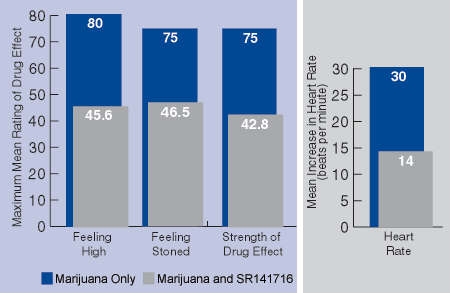Marijuana smokers treated with an experimental compound reported reduced highs and had smaller heart rate increases than untreated smokers in a recent study at NIDA's Intramural Research Program (IRP) in Baltimore. The finding confirms the pivotal role played in marijuana intoxication by certain structures -- called cannabinoid receptors -- on brain cells. In addition, the study suggests that the compound, called SR141716, may be useful as a medication to help marijuana smokers quit. (See also, "Study Opens Promising New Approach to Developing Medications To Prevent Relapse to Cocaine Use".)
Marijuana, like other psychoactive drugs, achieves its effects by attaching to nerve cells in the brain and altering their function. The main psychoactive component of marijuana, tetrahydrocannabinol (THC), attaches to cannabinoid receptors. Animal studies have led scientists to believe that a particular type of cannabinoid receptor is the site at which THC initiates the effects that produce marijuana intoxication.
"Studies have shown in laboratory animals that the CB-1 cannabinoid receptors, which are found in high densities in regions of the brain associated with attention, motor control, and reasoning, play a major role in the effects of marijuana. However, until our study, this had not been confirmed in humans," says Dr. Marilyn Huestis, an IRP researcher.
 Compound Reduces Marijuana Effect -
Participants received either placebo or active SR141716 before smoking marijuana and were then asked to describe, on a scale from 0 (not at all) to 100 (extremely), "How high do you feel now?" "How stoned on marijuana are you now?" and "How strong is the drug effect you feel now?" SR141716 (90 mg) reduced the maximum mean rating of the drug effects. Participants who received SR141716 also experienced smaller increases in heart rate after smoking marijuana.
Compound Reduces Marijuana Effect -
Participants received either placebo or active SR141716 before smoking marijuana and were then asked to describe, on a scale from 0 (not at all) to 100 (extremely), "How high do you feel now?" "How stoned on marijuana are you now?" and "How strong is the drug effect you feel now?" SR141716 (90 mg) reduced the maximum mean rating of the drug effects. Participants who received SR141716 also experienced smaller increases in heart rate after smoking marijuana.To evaluate the role of human CB-1 receptors, Dr. Huestis and her colleagues studied the effects of SR141716 in 63 adult men with a history of smoking marijuana. The compound was developed by Sanofi-Synthelabo, Inc., of Malvern, Pennsylvania, and clinical testing of the compound in marijuana users was conducted through a Cooperative Research and Development Agreement with NIDA. SR141716 has effectively blocked the effects of marijuana at CB-1 receptors in studies involving rats, pigeons, and monkeys. Participants in the NIDA research received doses of 1, 3, 10, 30, or 90 mg SR141716 or placebo. Two hours later, they smoked a marijuana cigarette containing THC or a marijuana cigarette without THC. Immediately after smoking and up to 65 minutes later, participants rated the strength of marijuana's effects on a scale ranging from 0 (no effect at all) to 100 (extremely strong effect).
"Participants who received the 90-mg dose of SR141716 reported 40 to 75 percent less drug effect than those who didn't receive the compound. Those who received lower doses of the compound also reported less drug effect," Dr. Huestis says. "This demonstrates, first, that CB-1 receptors play a major role in THC's effects in humans and, second, that SR141716 can be used to at least partially block the drug's effects."
In addition to its psychological effects on humans, marijuana increases the heart rate. Heart rates of men who smoked marijuana with THC but received no SR141716 increased by roughly 30 percent above baseline within 10 minutes of smoking marijuana and were 15 percent higher at 1 hour after smoking. Increases in heart rate after marijuana with THC was smoked were diminished in a dose-related manner by SR141716.
Blood tests showed that men who smoked marijuana with THC and who received 90 mg SR141716 had blood concentrations of THC similar to those of participants who did not receive SR141716. This demonstrates that reduction of marijuana's effects is attributable not to any effect of SR141716 on THC concentration, but to blockade of CB-1 receptors, Dr. Huestis says.
Because SR141716 partially blocks THC's intoxicating effects, the compound may prove valuable in treating marijuana addiction, the researchers say. If marijuana does not provide its usual high, patients in treatment would be less tempted to smoke it and less vulnerable to relapse. To evaluate the compound's role as a medication, NIDA researchers currently are studying SR141716's ability to reduce the effects of THC when given in repeated doses over 2 weeks. Other NIDA-supported research suggests that a different formulation of the compound may be effective in treatment of cocaine addiction (see "Study Opens Promising New Approach to Developing Medications To Prevent Relapse to Cocaine Use"). In addition, Sanofi-Synthelabo is investigating the compound's possible effects on other disorders related to cannabinoid receptors, such as increased appetite and food intake, and in smoking cessation treatment.
Source
- Huestis, M.A., et al. Blockade of effects of smoked marijuana by the CB1-selective cannabinoid receptor antagonist SR141716. Archives of General Psychiatry 58(4):322-328, 2001.
